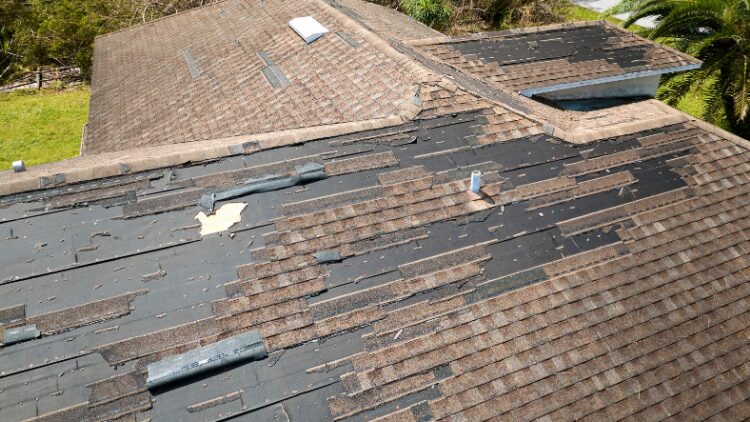Hurricane Roof Damage – What To Do
Hurricane season can be a challenging time for homeowners, especially when it comes to protecting your roof. After a storm, it’s crucial to know how to identify damage, what steps to take immediately, and how to navigate repairs and insurance claims.
This guide will help you understand the necessary actions to take after a hurricane has impacted your home.
Key Takeaways
- Inspect both the inside and outside of your home for signs of water damage.
- Always prioritize your safety before assessing roof damage.
- Document any damage thoroughly with photos for insurance claims.
- Use temporary fixes like tarps to prevent further leaks until repairs can be made.
- Consider hiring a professional roofer to ensure safe and effective repairs.
How to Identify Hurricane Roof Damage

After a hurricane, it’s crucial to check for hurricane roof damage. Here’s how you can do it safely and effectively:
Inspecting Interior Damage
Start by looking inside your home. Check for wet spots on ceilings or walls, as these can indicate leaks from the roof. Also, look for:
- Sagging areas in the attic
- Water stains on walls
- Light coming through cracks in the ceiling
Checking Exterior Damage
Next, walk around the outside of your house. Look for:
- Fallen trees or branches
- Damage to gutters or siding
- Broken windows or doors
Using Binoculars or Cameras for Roof Inspection
For a closer look at your roof, use binoculars or a camera with a zoom feature. This way, you can spot:
- Missing or damaged shingles
- Cracks in flashing
- Debris on the roof

Steps to Take Immediately After a Hurricane
After a hurricane, it’s crucial to act quickly to protect yourself and your home. Here are the steps you should follow:
Ensuring Personal Safety
- Stay indoors until local authorities declare it safe to go outside.
- Avoid walking through flooded areas to prevent electrical hazards.
- Be cautious of fallen power lines and debris.
Documenting the Damage
- Take clear photos and videos of any damage inside and outside your home.
- Make a list of damaged items and areas for your records.
- This documentation will be essential for your insurance claim.
Contacting Professionals for Inspection
- Reach out to a licensed roofing contractor to assess the damage.
- Schedule an inspection as soon as possible to avoid further issues.
- Remember, some damage may not be visible to the untrained eye, so a professional assessment is important.
Temporary Fixes for Hurricane Roof Damage
Using Tarps to Cover Leaks
When you discover a leak, the first step is to cover it up. Use a tarp that is at least 4 feet larger than the leak on all sides. This will help prevent further water damage until a professional can make permanent repairs.
Removing Debris Safely
After a hurricane, there may be debris on your roof. Carefully remove any branches or loose materials. Make sure to wear gloves and use a sturdy ladder. Safety is key here, so avoid climbing on a severely damaged roof.
Avoiding Further Damage
To protect your home, take these steps:
- Turn off electricity in affected areas to prevent electrical hazards.
- Move furniture and valuables away from leaks to avoid water damage.
- Document the damage with photos for insurance claims.

Hiring a Professional Roofer
When your roof has been damaged by a hurricane, it’s crucial to find the right help. Hiring a professional roofer can save you time and stress. Here are some steps to guide you:
Finding a Licensed Contractor
- Research local roofers: Look for contractors who are licensed and insured. This ensures they meet safety and quality standards.
- Read reviews: Check online reviews and ask for recommendations from friends or family.
- Get multiple quotes: Don’t settle for the first estimate. Compare prices and services from different contractors.
Verifying Insurance and Certifications
- Check their insurance: Make sure the contractor has liability insurance and worker’s compensation. This protects you from any accidents that may occur during repairs.
- Ask for certifications: Look for contractors certified by reputable organizations, as this indicates they have undergone proper training.
Understanding the Repair Process
- Ask questions: Don’t hesitate to ask the contractor about the repair process, materials used, and estimated timelines.
- Get everything in writing: Ensure you have a detailed contract that outlines the scope of work, costs, and payment schedule.
Remember, a well-chosen contractor can make all the difference in the quality of your roof repairs, especially when considering durability and weather resistance.

Long-Term Solutions for Hurricane-Prone Areas
When living in areas prone to hurricanes, it’s essential to take steps to protect your home. Choosing durable roofing materials can make a significant difference in your home’s resilience against storms. Here are some effective strategies:
Choosing Durable Roofing Materials
- Opt for materials like metal or clay/concrete tiles, which are known for their strength and resistance to severe weather.
- Ensure that your roofing system is designed to withstand high winds and heavy rain.
- Consider roofs with enhanced wind warranties for added protection.
Implementing Regular Inspections
- Schedule regular roof inspections to catch any potential issues early.
- Look for signs of wear and tear, such as loose shingles or rusted areas.
- Address any problems immediately to prevent further damage.
Investing in Comprehensive Insurance
- Review your insurance policy to ensure it covers hurricane-related damages.
- Consider adding wind or hurricane coverage if it’s not included.
- Keep documentation of your roof’s condition and any repairs made for future claims.
Hurricanes can be devastating, but there are ways to prepare for them. Building stronger homes and using better materials can help keep families safe.
If you want to learn more about how to protect your home from storms, visit our website for helpful tips and resources. Together, we can make our communities safer!
Final Thoughts on Hurricane Roof Damage
Dealing with roof damage from a hurricane can be tough, but knowing what to do can make it easier. First, always check for safety before going outside or inspecting your roof. Look for signs of damage inside your home, like wet spots or sagging ceilings.
Once it’s safe, take pictures of any damage you find. Contact a professional roofer to get a full inspection and help with repairs. Don’t forget to reach out to your insurance company to report the damage and start your claim.

Need Expert Advice on Your Roofing Project? Contact us today!
"*" indicates required fields
